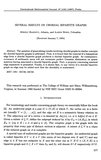Article
Full entry |
 PDF
(0.8 MB)
Feedback
PDF
(0.8 MB)
Feedback
 PDF
(0.8 MB)
Feedback
PDF
(0.8 MB)
Feedback
Summary:
The question of generalizing results involving chordal graphs to similar concepts for chordal bipartite graphs is addressed. First, it is found that the removal of a bisimplicial edge from a chordal bipartite graph produces a chordal bipartite graph. As consequence, occurance of arithmetic zeros will not terminate perfect Gaussian elimination on sparse matrices having associated a chordal bipartite graph. Next, a property concerning minimal edge separators is presented. Finally, it is shown that, to any vertex of a chordal bipartite graph an edge may be added such that the chordality is maintained.
References:
[1] M. Bakonyi: Completion of Partial Operator Matrices. Thesis, The College of William and Mary, Williamsburg, Virginia, August, 1992.
[2] M. Bakonyi, T. Constantinescu: Inheritance Principles for Chordal Graphs. Linear Algebra Appl. 148 (1991), 125–143. MR 1090757
[3] N. Cohen, C.R. Johnson, L. Rodman, H. Woerdeman: Ranks of Completions of Partial Matrices, in: The Gohberg Anniversary Collection, Vol I (Eds. H. Dym. S. Goldberg, M.A. Kaashoek and P. Lancaster). Operator Theory: Adv. Appl., OT 40, Birhäuser Verlag, Basel, 1989, pp. 165–185. MR 1038313
[4] M.C. Golumbic: Algorithmic Graph Theory and the Perfect Graph. Academic Press, New York, 1980. MR 0562306
[5] M.C. Golumbic, C.F. Goss: Perfect Elimination and Chordal Bipartite Graphs. J. Graph Theory 2 (1978), 155–163. DOI 10.1002/jgt.3190020209 | MR 0493395
[6] R. Grone, C.R. Johnson, E. Sa, H. Wolkowitz: Positive Definite Completions of Partial Hermitian Matrices. Linear Algebra and Appl. 58 (1984), 102–124. MR 0739282
[7] C.R. Johnson, L. Rodman: Completion of Partial Matrices to Contractions. J. Functional Analysis 69 (1986), 260–267. MR 0865223
[8] D.J. Rose: Triangulated Graphs and the Elimination Process. J. Math. Anal. Appl. 32 (1970), 597–609. DOI 10.1016/0022-247X(70)90282-9 | MR 0270957 | Zbl 0216.02602
[9] D.J. Rose, R.E. Tarjan, G.S. Leuker: Algorithmic Aspects of Vertex Eliminations on Directed Graphs. SIAM J. Appl. Math. 34 (1978), 176–197. DOI 10.1137/0134014 | MR 0488988

